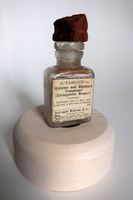Items
Site
The Medicine Chest
keywords is exactly
Kimberley
-

Livingstone
A small wooden chip from the same object collection as the medicine chest balanced on top of one of the bottles from the chest. "The treatment, the Livingstone rouser, was formulated by Dr Livingstone, who, after an attack of malaria in 1853, patented this mixture of quinine and purgatives (calomel, rhubarb and jalop) mixed with opium (Barrett & Giordani 2017: 1655–1666). The chip balanced on its lid is said to be from the almond tree under which he proposed to Mary Moffat in 1844. The juxtaposition of these two objects, one representing the quantifiable and the other the poetic, draws the viewer to consider the conflation of these two realms" (Liebenberg 2021: 273). -

Prisoners on a Projecting Platform
Etching from Giovanni Battista Piranesi's 'Carceri d'invenzione (Imaginary Prisons)' ca. 1749–50 -

The Pier with Chains
Etching from Giovanni Battista Piranesi's 'Carceri d'invenzione (Imaginary Prisons)' ca. 1749–50 -

Kimberley, South Africa: miners and washing gear at the Bultfontein diamond mine
Woodburytype -

Griqualand West, South Africa: Kimberley diamond mine.
Woodburytype -

Kimberley Mine
A detail from the wallpaper used outside the Cape Town Diamond Museum in the V&A Waterfront. -

The Drawbridge
Etching from Giovanni Battista Piranesi's 'Carceri d'invenzione (Imaginary Prisons)' ca. 1749-50 -

Kimberley Mine 1886
Plate from Williams, G. 1902. 'The Diamond Mines of South Africa: Some Account of their Rise and Development'. New York, London: Macmillan. -

Kimberlite
A display outside the Cape Town Diamond Museum in the V&A Waterfront -

Kimberlite
Kimberlite specimens, UCT Mantle Room -

Kimberlite
Kimberlite specimen, UCT Mantle Room -

The Diamond Mines of South Africa: Some Account of their Rise and Development.
“In the mines operated by the De Beers Company alone, more than eleven thousand African natives are employed below and above ground, coming from the Transvaal, Basutoland, and Bechuanaland, from districts far north of the Limpopo and the Zambesi, and from the Cape Colony on the east and the south to meet the swarms flocking from Delagoa Bay and countries along the coast of the Indian Ocean, while a few cross the continent from Damaraland and Namaqualand, and the coast washed by the Atlantic. The larger number are roughly classed as Basutos, Shanganes, M'umbanes, and Zulus, but there are many Batlapins from Bechuanaland, Amafengu, and a sprinkling of nearly every other tribe in South Africa” (Williams 1902: 412-413). -

The Diamond Mines of South Africa: Some Account of their Rise and Development.
“The initial impetus for establishing a collection of mantle materials for research purposes in South Africa was provided by Gardner Williams and his son Alpheus Williams in the late 19th and early 20th century. These two American mining engineers shared a great interest in the mining methods and geology of the South African kimberlite-hosted diamond mines they were supervising. Each wrote books on the subject and the two men assembled a collection of scientifically interesting rock samples and minerals from the mines. Subsequent to the death of Alpheus Williams, the Williams family donated this collection to the Geology Department at UCT for teaching and research purposes” (Department of Geological Sciences 2021). -

Chip of wood from an almond tree
Said to be a chip from the tree under which David Livingstone is said to have proposed to Mary Moffat 1884. Wood chip was donated by R.F. Immelman who purchased it from Kimberley museum. -

Smallpox
"In Kimberley in 1883-4, several leading doctors with links to the diamond-mining industry publicly denied the presence of smallpox among migrant workers, instead diagnosing them as suffering from a rare skin disease. They appear to have done so lest admitting that the dreaded smallpox was raging, which would have affected the supply of labour and materiel and thereby interrupting mining operations. Led by Cecil Rhodes’s friend, Dr Leander Starr Jameson, measures to curb the epidemic were sporadic or, in the mining compounds, non-existent, and cases topped 2000, with mortality at 3.5 per cent of the population. Only when the colonial government eventually called in external doctors to diagnose the disease, was the cover-up terminated and vaccination, fumigation and isolation vigorously pursued. The conspiracy of denial, by retarding action and sowing doubt about the need to be vaccinated, had been responsible for no small percentage of the 700 deaths in the town" (Phillips 2012: 32-33). -

Kimberlite
"UCT was founded in 1829 as the South African College, a high school for boys. The College had a small tertiary-education facility that grew substantially after 1880, when the discovery of gold and diamonds in the north – and the resulting demand for skills in mining – gave it the financial boost it needed to grow. The College developed into a fully fledged university during the period 1880 to 1900, thanks to increased funding from private sources and the government. During these years, the College built its first dedicated science laboratories, and started the departments of mineralogy and geology to meet the need for skilled personnel in the country's emerging diamond and gold-mining industries (Ritchie 1918: 495-496)".


